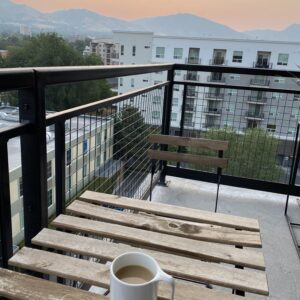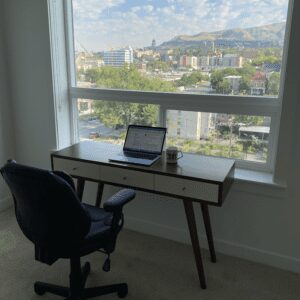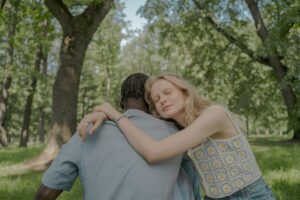When I was a preschooler I apparently drove my mother a bit up the wall with always wanting to “Go outside” (pronounced “Go out-SAHWD.” with a serious Texas drawl). I remember getting up on Saturday mornings or summer mornings as an elementary schooler at my home in San Antonio and immediately getting dressed and bolting out to the front yard. Mornings were the only time of day one might enjoy being out-SAHWD in south Texas when it’s 98 degrees for days on end with 80 percent humidity. I was not going to waste a moment of it. I think that most days I was outside and ready to play by 6:30 am, though most friends on my street were still slumbering. Being by myself did not bother me so long as I could take a deep breath and fill my lungs with the cool(ish), fresh morning air. My mom is less of an outdoor fanatic and I wore her out with my obsession.
My love of the outdoors continues and is a primary reason I still live in Utah. The mountains, in particular, call my name whether it’s for skiing or snowshoeing in the winter or hiking the rest of the year. The breath-taking red rock of Moab. The various rivers and lakes for kayaking, swimming, or just listening to the water’s movement. The feel of pine needles under my feet or the faint sound my footfalls make as I trek along a soft, damp hiking trail after a rain shower. Being outside has often been a reliable place or experience of recovery and restoration for me. I thought I was just weird (or wired) that way. The research suggests this is the way all humans are wired. Whew!
The Mind
Being outdoors or in nature has numerous and perhaps unexpected benefits for our minds. A 2021 study of veterans with post-traumatic stress disorder (PTSD) demonstrated that time spent outdoors reduced their symptoms such as having nightmares, helped them avoid places or situations that remind them of the traumatic combat event, reduced feelings of numbness, or that the world is a dangerous place, improved their ability to sleep and concentrate, and decreased their feelings of guilt or shame. The more time the veterans spent outdoors, the fewer their PTSD symptoms. Extreme mental health challenges like PTSD can be helped by time spent outside.

Interestingly, though maybe not surprisingly, this research was carried out in beautiful Park City, Utah. Park City is where I spent several days this month taking a Think Week. Well, kind of. A setback the week before my Think Week left me in a very low spot emotionally and mentally. Plus I was feeling beyond stir crazy working at home due to spending so much time there during the pandemic. I was almost at my wits end. That setback and the resulting state of mind motivated me to shift those days from “think days” to “hitting reset days.” I booked a hotel room for three nights. I got outside every morning to run, walk, or hike. One day, I found a shady trail and took an easy urban hike in the afternoon. Between outdoor stints, I holed up either in my room or the hotel common areas to think, read, and write. Within 24 hours of landing in Park City, my headspace vastly improved and I developed a potential solution to that setback. I felt more in control of my thoughts and emotions. My mental and emotional outlook on life and what was possible were more optimistic. (See photo from one of my runs among the trees in Park City).
Being outdoors, especially under leafy green vegetation also fosters what psychologists called “soft fascination.” It is a state of effortless attention where nature helps us focus on, comprehend, and enjoy multiple stimuli at one time. These experiences ease our mental fatigue and replenish our brain. One study found that time in a greenspace lowers our frustration and increases our engagement after leaving the greenspace. Part of these effects likely stem from our ability to reflect when in nature while we take in all the colors, sounds, and aromas that a climate-controlled office building does not provide.
Time spent outdoors has another benefit for the mind – it boosts creativity. Consider that nature is constantly changing. From a continuously flowing river, to the growth of the trees – nature adapts. Nature is also a problem solver. With time, it heals itself and can become stronger due to hardship as is the case with forest fires. Likewise, being in nature can help us restore our minds and make them stronger and more at peace than if we stayed holed up inside watching Netflix for several hours each day.
The Body
There are numerous tangible or physical benefits to spending time outdoors. Sunlight exposure increases our vitamin D, which subsequently boosts our immune system and fights against cancer, heart attack, stroke, and osteoporosis. Those who spend regular time outdoors also get better sleep. Being outside may also increase our likelihood of being physically active, which of course has all kinds of benefits for maintaining a healthy weight, improving our cardiovascular health, and enhancing our sense of balance and coordination.
The Soul
Being outdoors and especially in nature is food for the soul. Simply being in nature improves our self-esteem. Outdoor activities often are done with others so it can provide an opportunity for social engagement, particularly important for extroverts who draw their energy from being with other people. It can be a two-fer! We can draw energy from being outside as well as from being with friends, family or coworkers. Sometimes time outdoors can work in the opposite direction – it gives us time alone. Time with our thoughts and to think without interruption. Time for silence and mindful contemplation. Consider whether you lean towards extroversion (i.e., you gain energy from being social) or towards introversion (i.e., you replenish your energy supply by having time by yourself). Then base how you spend time outside based on that mechanism for restoration. It doesn’t have to be all or nothing. But when you’re feeling mentally and emotionally depleted, get outside and either take a friend, or don’t!
Get Out More
A 2017 study, The Nature of Americans National Report, indicates that 60 percent of American adults spend five hours or less in nature each week. Further, parents of 8 to12-year-olds said that their children spend three times as many hours per week on a computer and watching television as they do playing outside. The knowledge economy, computers, televisions, and smartphones often translate to spending even more time indoors, much more time compared to our ancestors. A 2019 study suggests that Americans want to get outside and in nature more, but the biggest obstacle to that is…wait for it…work.
Not every job will allow the time, location, and logistics to work in nature or even to work outdoors. Those who work in manufacturing roles or with customers may face greater hurdles to working outdoors. However, there are ways to incorporate some outdoor time into our work schedule or work life.
Walk & Talk
Those who watched the television drama The West Wing will remember that countless scenes in the show were shot as characters talked and walked speedily from one wing of the White House to another. My partner has countless phone calls with his team members and clients. Regularly, he will take these calls outside and walk around our neighborhood in Salt Lake City while getting an update from the team or pitching an idea to a client. If you have a call to make, either with an individual or a group, aim to do so outdoors. Your path will probably need to be away from traffic noise and thus you may need to get to that quieter spot before the phone rings. For many, walking while they listen to the other participants on the call helps them focus more on what is being communicated.
Think Walk
If you’re more introverted or think better on your own, take a Think Walk when a work problem strikes mid-day. The physical act of walking facilitates creative thinking and thus problem-solving. It can also relieve stress and frustration with a boss or colleague, not that any of us know anything about that. Look at the sights around you, even if you’re in an urban area. Listen to the sounds. Sometimes even the hum of a busy downtown area can be calming.
Meet Outdoors
At times, walking and talking during a meeting is not feasible because you need your laptop in front of you or other materials to refer to that make walking during the conversation untenable. If so, find a spot outside to sit and have your meeting. It might be in the sun or in the shade – your preference. Meeting outdoors can be highly effective for collaborative problem-solving. Being outside often helps expand what scientists call the “thought-action repertoire.” This means being outside expands our minds to consider thoughts and then subsequent behaviors or actions that we might otherwise have not considered or thought possible. It broadens our thinking and helps us build upon that thinking with a wider range of actions that may help us solve our problem. Expanding the thought-action repertoire is critical for problem-solving.
Reading
Have a report to read or data to digest? Take it outside. Fresh air and vitamin D from the sun’s rays may help you concentrate better on the information you’re taking in. It may also help you find holes or inconsistencies in what you’re reading, or what you’re writing.
The Outdoor Office

If you’re a knowledge worker, chances are you use a laptop most days and may also have the flexibility to work out of the office, especially during and post-pandemic. Take that laptop outside. Maybe to a park with picnic tables under a pavilion. Or to a nature trail or urban park that has benches. Or perhaps at home if you have an outdoor living space such as a balcony (it doesn’t have to be large), deck, or covered patio. During the month of June, I aim to spend almost the entire day in a shady spot working outside here in northern Utah. Other parts of the country — yes, Texas, I’m giving you the side-eye — may not support that except very early in the morning.
Breaks
Take your lunch break or just a break to stretch your legs and do it outside. It is amazing what a 10-minute walk outside can do for the physical tension and mental fatigue that can build up over a long workday. Some cultures make this a practice. When I worked at the Deloitte office in Den Bosch, The Netherlands, I learned that the organizational culture there was to eat a quick lunch together in the breakroom and then for the entire team or office group to head outside for a 15 to 20-minute group walk around the office complex. It was unexpected and a bit bewildering at first, but the practice really grew on me. Gone were the, “I desperately need a nap.” thoughts after lunch. I felt energized and slightly more connected to my new colleagues.
Alternatives

Not everyone and probably not even a majority of us have ready access to green spaces or to natural spaces. Further, there is differential access to or inequity of availability to greenspace, often based upon affluence. However, those who live in urban locations, far from parks or nature, or in climates where being outside is not particularly feasible, much less comfortable, are not without options. A 2016 study of the effects of natural elements and sunlight found that being near indoor plants can boost job satisfaction, and reduce anxiety and depression, making many of us more productive. Even natural elements that are indoors such as window views of nature, photographs of a natural setting, or screensavers depicting nature improved mood and the individual’s commitment to their employer. Other evidence indicates that being near an indoor plant enhances creativity. So find a window or plant to work near. If you are like me and only have a black thumb instead of an even mildly green one, try getting a succulent. Though I have failed to keep alive almost every plant I have ever owned, I have found succulents relatively easy to keep happy. Pretty much ignore them, except for occasional watering, and you’re good to go.
Bottom line: It is good for the mind, body, and soul to GET OUT(side). If it’s good for the individual, it’s likely good for our organizations to facilitate their people working or getting outdoors during the workday. Get outside today, even if for just a 10-minute walk. Help others do the same by sharing this post with your boss and asking how you and your colleagues can take work outdoors.






